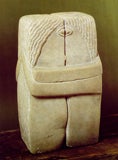| Project IVJ |
Attractive Opposites |
| Objectives |
studio fundamentals: To introduce both traditional and non-traditional approaches to the concept of mass as applied to three-dimensional form. concept/theme: to explore methods of reconciling opposites--whether by use of symbolic form, choice of material, or method of treatment. |
| Project Overview | Your challenge is to create a sculpture in two parts that expresses both the idea of sculptural mass and the idea of "relationship." |
|
Project References
|
Scott Burton, Ursula Von Rydingsvard, Aristide Maillol, Venus of Willendorf, Gianlorenzo Bernini, Coatlicue, Claes Oldenburg, Henry Moore, Eduardo Chillida, Elyn Zimmerman, Bruce Beasley, Eva Hesse, Easter Island statues, Beverly Pepper, Jacque Lipchitz, Rock Garden at Ryoan-Ji Temple, Analdo Pomodoro, Michelangelo, Barbara Hepworth, The Great Pyramids at Giza, Gudea Worshiping, Constantin Brancusi, Alberto Giacometti, Jean-Baptiste Carpeaux, Michael Heizer, Marisol, Gaston Lachaise, Arata Isozaki, John Chamberlain, Edgar Degas, Auguste Rodin, Jackie Winsor, Hitching Post of the Sun (The Intihuatana Stone at Machu Pichu), George Segal, Isamu Noguchi |
| Vocabulary | mass, density, weight, gravity, form, simulation, surface, tactile, traditional/non-traditional, subtractive, synthetic |
|
Materials
|
plaster (provided) or other solid substance (wood, blue styrofoam, etc.), mixing bucket for plaster, an assortment of "found" carving tools (kitchen knives, gouges, chisels, old screw drivers, etc.), sand paper, two identically sized molds (cardboard preferred) for casting the plaster (e.g., two oatmeal boxes, two milk cartons, etc. Or make your own with corrugated cardboard and hot glue.)Consider the relative advantages of various "carvable" materials. For this project you will be working "subtractively" and you will need to consider the kind of tools you have at your disposal, the material itself (e.g., plaster, alabaster, foam) and the level of detail you are trying to achieve. |
| Process |
Preliminary: 1. Before coming to class read the discussion Mass for Unit IV. Review the Project References above. Activities: a) Generate a list of "oppositions"
(opposing terms) that can be used to describe the physical properties
of objects, e.g., light vs. heavy, soft vs. hard. Put in your notebook. c1) Using cardboard molds,
cast two volumetric solids of plaster. Maximum dimension not to exceed
10 inches. Using one pair of oppositions from your list, carve your plaster
forms in ways that illustrate your opposing terms. For example, if your
terms are "soft vs. hard", you would carve one block to appear
"soft," the other block to appear "hard." Challenges: (optional): Combine your sculptures into a single sculpture. Try to use materials other than plaster to work "subtractively" (e.g., hydrocal, stone, wood, etc.) "Simulate" one of your terms using the most illogical material, e.g., a lead balloon. Combine other ways of describing a spatial volume with your sculpture, e.g., surfaces, contour lines. |
|
Critique Ideas
|
When
you have completed your sculpture, divide into small groups and exchange
artworks with another group from the class. Within your group, work together
to respond to each sculpture in turn. Consider the following: 2. Did the artist use traditional or non-traditional approaches to the concept of mass? 3. How effectively did the artist "reconcile opposites" as per the objectives? 4. Discuss ideas the artwork seems to communicate. After some sharing of interpretations, attempt to state the "message" of the design in one sentence. (This artwork is about. . .) |
|
Notebook
|
Your notebook should include
the following: 2. Your design process (drawings, computer-printouts, photos). 3. Supplemental materials (receipts, notes about technique or materials) 4. Documentation of the final work. |




